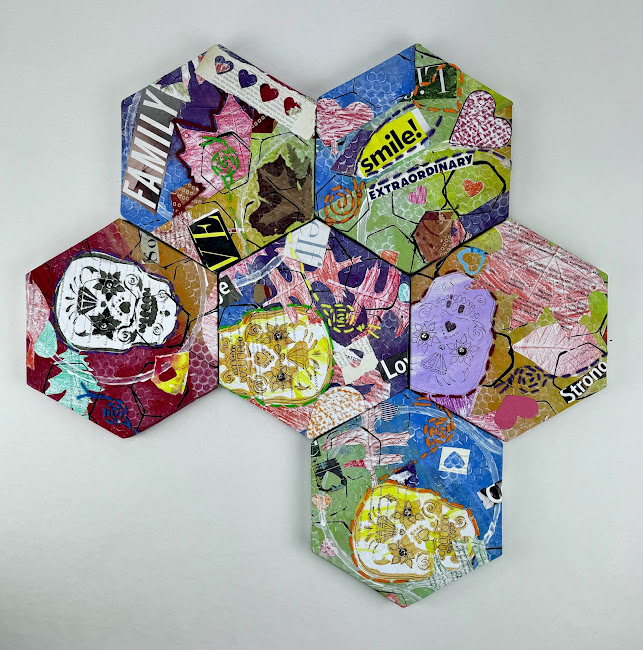Reagan Weaver responds to Rebecca Eckland's Honeycombs
When visiting the Honeycomb project art exhibit at Reno City Hall, I immediately grabbed the book and searched through the pieces with their artist statements. I was interested in the design by Rebecca Eckland, featuring an owl, a sunrise, a feather, aspen trees, a barren tree with wildflowers, and a winter scene. These pieces drew my attention because of their connection to the natural world. The owl and the landscapes portrayed caught my attention because they are everyday things in my life: I often find feathers and hear owls at night at home, which piqued my interest in the meaning of these pieces to the artist. Another reason these pieces caught my eye was the general beauty of the aspens and the natural landscape, the owl's striking eyes, and the artist's color palette. I thought these were quite an eye-catching, unique piece. The background writing also caught my attention, with the contrast between the black canvas and the white text. I found the artist's description fascinating, as Miss. Eckland had experienced a debilitating injury, which caused her to question her identity, as she had spent a lot of her time as an athlete; this injury would cause her to no longer be able to perform at the physical level. As I read her piece, I found her journey inspiring, as she found a way to move on and find enjoyment in her life by returning to her artistic roots through this project. Additionally, I enjoyed learning about the wayfinders and the cost of finding a way, and that finding a way isn’t always about arriving at a destination but about making the journey. This really affected me, as I struggled to find community at my school, which led me to question my worth as a person because I had no close friends immediately around me. But this struggle led me to find a friend somewhere else, even if that meant they lived 5-8 hours away. I only saw them on special occasions, but to find a destination, I had to figure out how to get there.
After looking at the six canvases by Rebecca Eckland, I took in the piece as a whole and was overcome by a deep sense of awe at the scale of this art and the vast reach of this project. With so many participants in the project, I couldn’t help but think how almost every person in the world could find an artist or project in this piece that they would relate to. I was visually intrigued by the different textures featured in this work, from the mosaic to the ceramics to the paperwork, which almost made origami flowers, along with the fabric pieces that used beads or pins in their art. I also enjoyed the different subjects depicted in the art, from florals to animals, landscapes, and Nevada-themed pieces, which sparked my interest as a native Nevadan. One large-scale piece also helped drive the theme of interconnectedness between people. Another aspect of the design is the piece's positive and negative areas. This made me realize that there is more room for others in society, since not every available spot in the piece is taken. The piece's positives and negatives also gave it shape and made the artwork visually intriguing. Another thing that made me think is what would go into creating a piece like this, with the different ways to hang the art, and how to facilitate the creation of many people. It was an imposing piece.
This pace made me see similarities in other people's styles, but even through our different choices in medium, style, subject, and message, there is a connection between us all. Even though we may not be immediately connected to one person, there is always a trail to each person.







Comments
Post a Comment